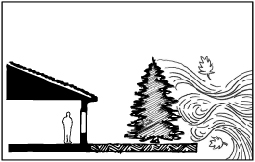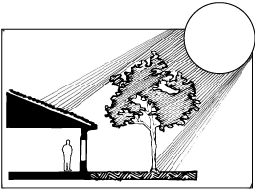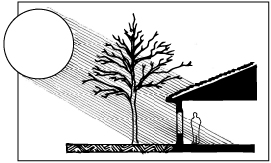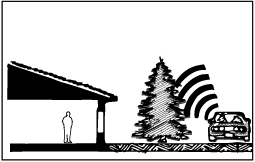Location, Location, Location

It's all about the real estate that you select for the forever home for your future tree. Well placed trees can help conserve energy and add to the appearance of your home and neighborhood. While a tree in the wrong place can be harmful and expensive
Remember that the small tree you plant today will increase in size over many years. Make sure you select a location with adequate room to grow; both below ground for roots and above grown for the crown.
The below information provides guidance on things to consider before you plant. For additional guidance on determining where to plant the tree, including recommendations for how far to place trees away from property lines and utilities, view our Tree Placement Card.
Power Lines
Never plant trees with a mature height of greater than 25 feet directly below overhead power lines. Trees reaching 25 to 40 feet in height when mature should be located at least 30 feet away from power lines. Trees growing to be over 40 feet tall when mature should be located a minimum of 50 feet from the overhead power lines. Do not confuse communication lines (the lower and thicker black lines) for power lines.
Pavement
Avoid planting trees too close to a driveway or sidewalk. Large tree roots (which are typically larger with bigger trees) can lift and break pavement, creating hazards and additional repair costs. In Tacoma, the standard is a minimum distance of 2 feet from tree to pavement surface.
Building Setbacks
The crown of a tree at maturity should not be in serious conflict with the neighboring structures. Consider selecting narrower crowned trees in areas where buildings are dense to reduce conflict potential.
Sun Exposure
What kind of exposure to the sun does the area receive? Is it full sun all day long? Is it part-sun? If so, with morning or afternoon sun exposure?
Sun exposure will affect the species of tree you select, as some perform best with protection from the afternoon sun, some are shade tolerant and others prefer full sun. Knowing your space will help narrow tree species options.
 Wind Protection
Wind Protection
Trees planted as windbreaks have the potential to insulate a property and reduce the need for additional heat during the winter. Windbreaks are typically planted as a double staggered row of medium to large trees which are planted perpendicular to the dominant direction of the wind.
Energy Savings - Summer Cooling
Well-place shade trees on the north and west sides of a home will shade the home from the direct sun during the summer which can lower air conditioning costs by up to 35 percent.
Energy Savings - Winter Warming
Deciduous trees on the south side of a home will allow for the sun to penetrate through the bare branches and warm the house after the leaves have fallen during the fall and winter. 
Noise Reduction
Planting "noise buffers" composed of trees and shrubs can reduce noise by 5 to 10 decibels; that equates to noise reductions of approximately 50 percent to the human ear. In an area that frequently experiences noise pollution, dense evergreen trees are perfect for warding off the noise.
Visual Buffers
In areas with conflicting or undesirable development or site uses, trees can be an excellent buffer to unattractive features. It is important however to take special care not to block important sight lines that are necessary for public safety.
Soil Type
What type of soil is present? Is it currently turf? Planting bed? Is the soil a healthy dark brown (more fertile) and easy to dig in? Or is is a pale brown-grey (less fertile) and tough to dig in? Somewhere in between? Make sure to check. Some trees are more tolerant than others growing in less fertile soils. Knowing the soil type in the location of where you plan to plant and grow your tree will help narrow the tree species options.
Root Space
In urban environments, the topsoil is frequently shallow, compacted, and drought prone. Many species of trees are unable to thrive in these conditions, especially during the establishment phase. In poor soil conditions additional maintenance needs, and in some cases soil remediation, will need to be performed to adequately grow trees.